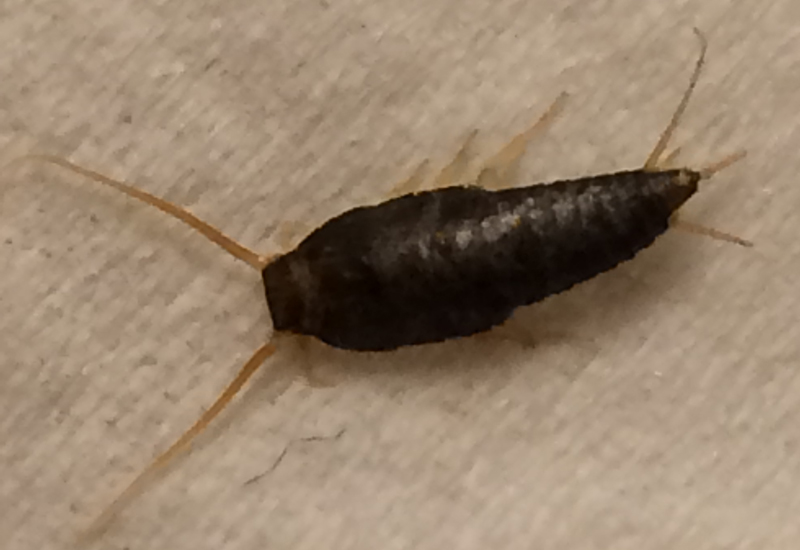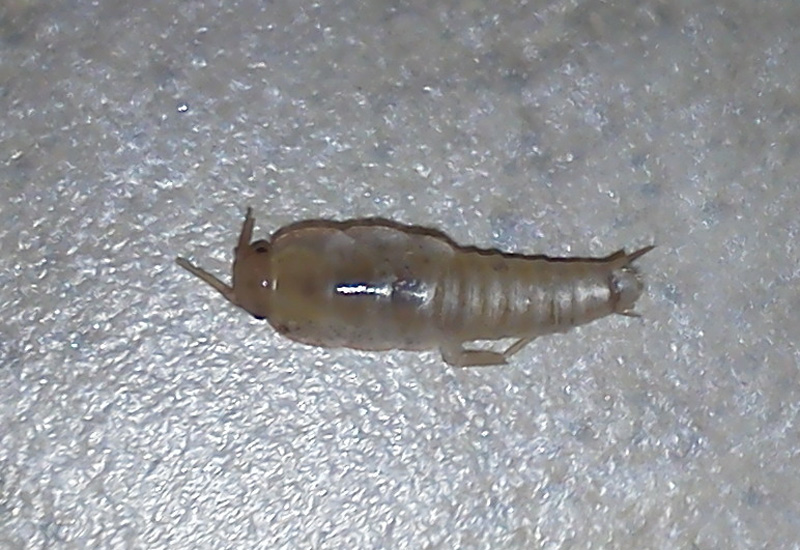Silverfish are a common household pest that many people encounter.
Although their name might lead you to believe they have a silver, slippery exterior, they are actually wingless insects with a grayish-blue, scaly appearance.
Despite their somewhat creepy appearance, silverfish are not considered dangerous to humans.

These insects do not bite, sting, or spread diseases. However, they do have the potential to be a nuisance, as they can damage household items.
Silverfish are known for their love of eating starchy materials, such as paper, cardboard, glue, and even fabric.
This can lead to damage to books, wallpaper, and clothing, among other items.
Although they don’t pose a direct health risk, it’s still important to address a silverfish infestation before it gets out of hand.
Are Silverfish Dangerous?
Harmful Effects on Humans
Silverfish are not known to pose any direct harm to humans. They are not:
- Poisonous
- Capable of transmitting pathogens
- Known to cause allergic reactions
In fact, their weak jaws make it difficult for them to bite people or pets.
However, it is worth mentioning that some individuals may be more sensitive to silverfish and could potentially experience an allergic reaction, although this is not common.
Potential Damage to Household Items
While silverfish may not be harmful to humans or pets, they can cause damage to household items. They typically feed on:
- Glue in book bindings or behind wallpaper
- Paper and paper sizing
- Cereal grain products
- Dried meat
- Silk and some synthetic fabrics
Here’s a comparison table to help illustrate the potential damages:
| Household Items | Silverfish Damage | Prevention Tips |
|---|---|---|
| Book bindings | Eat the glue | Store books in a dry area |
| Wallpaper | Eat the glue | Use wallpaper with low adhesive |
| Paper products | Eat paper | Store papers in a dry area |
| Food items | Contaminate | Store food in airtight containers |
| Clothing materials | Damage silk and synthetic fabrics | Store clothes in a sealed container |
To prevent silverfish damage, it’s essential to maintain a clean and dry home environment, as they thrive in cool, damp, and dark areas.
By minimizing excess moisture and clutter, you can help keep silverfish at bay, protecting your household items from potential damage.

Understanding Silverfish
Physical Characteristics
Silverfish, scientifically known as Lepisma saccharina, are small insects with a unique appearance that resembles a fish. They are:
- Silver or pearl-gray in color
- Covered in tiny glistening scales
- Wingless
- About 0.85 cm (0.33 in) in length
- Possess two long antennae1
Diet and Feeding Habits
Silverfish prefer consuming materials of plant origin, particularly those high in carbohydrates and protein. Some examples of their diet include:
- Glue in book bindings or behind wallpapers
- Paper and paper sizing
- Cereal grain products
- Dried meat
- Silk and some synthetic fabrics2
Habitat and Lifecycle
Silverfish are nocturnal insects that thrive in dark, damp places, such as bathrooms and basements. Their life cycle consists of the following stages:
-
Eggs: Females lay over 100 eggs during their lifetime, either singly or in small groups.
-
Hatching: The eggs hatch within three to six weeks.
-
Young Silverfish: Resembling smaller, more white versions of the adults, they darken in color within four to six weeks3.
- Adulthood: Adult silverfish live for two to eight years.
In comparison to other pests, silverfish are not as dangerous, being primarily a nuisance.
However, they can cause damage to your household items due to their feeding habits.

Attractants and Problem Areas within Homes
Susceptible Items
Silverfish are attracted to various items found in homes. They are especially drawn to:
- Food: cereals, rolled oats, and other starchy foods
- Books and paper: wallpaper, magazines, and newspapers
- Textiles: cotton, silk, and synthetic fabrics
- Glue: found in bookbindings, cardboard boxes, and wallpapers
They may cause damage by chewing on these materials. For instance, they leave feeding marks, yellow stains, or feces on the infested items.
Common Areas for Infestation
These wingless insects prefer dark, moist environments. In homes, they usually infest:
- Basements
- Attics
- Crevices in walls
- Spaces behind wallpaper
- Underneath or within carpets
To minimize infestations, consider implementing the following strategies:
- Seal crevices: Close gaps and openings in walls, floors, and ceilings.
- Dehumidify: Use a dehumidifier to maintain a dry environment.
- Eliminate water sources: Fix plumbing leaks and ensure proper ventilation.
- Vacuum and dust: Regular cleaning can minimize the presence of silverfish.
- Proper storage: Store food, books, and fabrics in sealed, airtight containers.
| Tips for Prevention | Pros | Cons |
|---|---|---|
| Seal crevices | Stops silverfish from entering | Time-consuming |
| Dehumidify | Creates an unfavorable environment | May increase energy costs |
| Eliminate water sources | Reduces moisture and mold | Requires regular inspection |
| Vacuum and dust | Maintains a clean living space | Demands ongoing effort |
| Proper storage | Protects susceptible items | Takes up additional space |
Remember, silverfish are not toxic, but they can be a nuisance and may cause allergies in some individuals.
By understanding the attractants and problem areas within your home, you can better protect your belongings and create a less hospitable environment for these pests.

Prevention and Control Methods
Home Improvement Measures
To prevent silverfish infestations, focus on reducing their habitats and food sources. Some measures to consider:
- Seal cracks and crevices in your home to eliminate hiding places. Caulking is especially useful for this task.
- Use dehumidifiers to reduce moisture levels in humid areas like bathrooms and basements.
- Store food in airtight containers to limit their access to food sources.
Natural and Chemical Treatments
There are several natural and chemical treatments available to help control silverfish populations:
- Diatomaceous earth, a natural substance that causes insects to dehydrate and die, can be sprinkled around potential hiding spots.
- Boric acid is another natural option that can be applied to cracks and crevices.
Some chemical options include:
- Insecticides with active ingredients like bifenthrin, cyfluthrin, tetramethrin, and phenothrin can be applied as sprays or baits.
- Traps baited with synergized pyrethrin attract and kill silverfish.
Keep in mind, chemical treatments should be used carefully and according to the product instructions.

When to Call a Professional Pest Control
It is essential to know when to call an exterminator for a silverfish infestation. Consider professional pest control services if:
- You notice yellow residue or fecal matter, indicating a large infestation.
- Home improvement measures and treatments are not effectively reducing the silverfish population.
- The infestation is causing damage to items such as cotton curtains, dried meat, or anything with cellulose-based materials.
Remember, tackling an infestation early is crucial to minimize potential damages and to restore a pest-free environment.
Footnotes
Conclusion
Silverfish are ancient insects that have been around for millions of years. They are nocturnal and secretive, and they prefer to live in dark, moist, and warm places.
Silverfish are not dangerous to humans or animals, as they do not bite, sting, or transmit diseases.
However, these bugs can be a nuisance and a potential source of damage to household items, such as books, papers, fabrics, wallpaper, and food.
Silverfish infestations can be prevented or controlled by reducing moisture, sealing cracks and gaps, removing clutter, and using traps or insecticides.
Silverfish are not harmful creatures, but they can be annoying and destructive if left unchecked.
Reader Emails
Over the years, our website, whatsthatbug.com has received hundreds of letters and some interesting images asking us about silverfish. Scroll down to have a look at some of them.
Letter 1 – Silverfish
White bug in my kitchen
January 4, 2010
I went to make spaghetti this afternoon and when i reached for my pot this little fellow was walking around inside.
I’m all for exotic foods, but this was just a little much. I live in California, so my first thought was some kind of cockroach, but i couldn’t find one that looks like this. I’m just really curious what this little guy is – please help out!
Sorry for the picture, My Cell phone is the only camera around right now.
No Bugs For Me
California

Dear No Bugs For Me,
While the way you signed your letter suggest an unrealistic world view, we will admit that the Silverfish in your photo is an inhabitant you probably do not want reproducing in your home unchecked.
They are considered household pests whose diet, according to BugGuide, is: “omnivorous: starchy foods, cereals, moist wheat flour, glue on book bindings and wallpaper, starch in clothing made of cotton or rayon fabric; outdoor individuals eat lichens.”
Letter 2 – Silverfish

I find this bug in my master bathroom. It’s always crawling on the wall, only one by itself but i’ll see it once or twice a week. Sometimes it’s on the wall of my bedroom. Any idea what it is? Please!!!
Nancy

Hi Nancy,
We have received several requests in recent weeks to identify a Silverfish, but we have not posted a new image of a Silverfish since it was Bug of the Month in March 2007. Silverfish are primitive insects that can become established in homes and become household pests.
They are usually found in dark damp areas and they are known to damage books by feeding on the organic glue and sizing in the binding and also do damage to wallpaper. They eat many forms of dry organic matter and will also feed on sugar, flour, breakfast cereals, fabrics and insulating materials.
Letter 3 – Silverfish
three-pronged tail antennae
August 31, 2009A few of these little guys were crawling around in and on the mailboxes for my apartment complex.
I saw one when I opened the mailbox around noon, at which point that one and a couple others scurried away out of the mailboxes through some cracks, onto a wall.
At first I thought it was a roach nymph because of the way it moved, but it looks too skinny and has these 3 tail antennae. Thanks!
Nick
Austin, TX

Hi Nick,
You have done an amazingly accurate drawing of a Silverfish considered it scurried away.
Letter 4 – Silverfish
SPECKO ROACH (Cockroach+Gecko+Spider)
July 6, 2010
Ahem. Well I just found this bug crawling on the wall in my house and thought it was super interesting looking.
I’ve never seen this kind of bug before so I was just curious as to what it was., although I’ve already given it a name. =]
Uh…what?
My house….which is in a normal suburb area with crazy Texas weather.

Silverfish are generally considered household pests because they will eat most anything, from human and pet food, to the starch in book bindings.
The post Are Silverfish Dangerous? Uncovering the Truth appeared first on What's That Bug?.

No comments:
Post a Comment